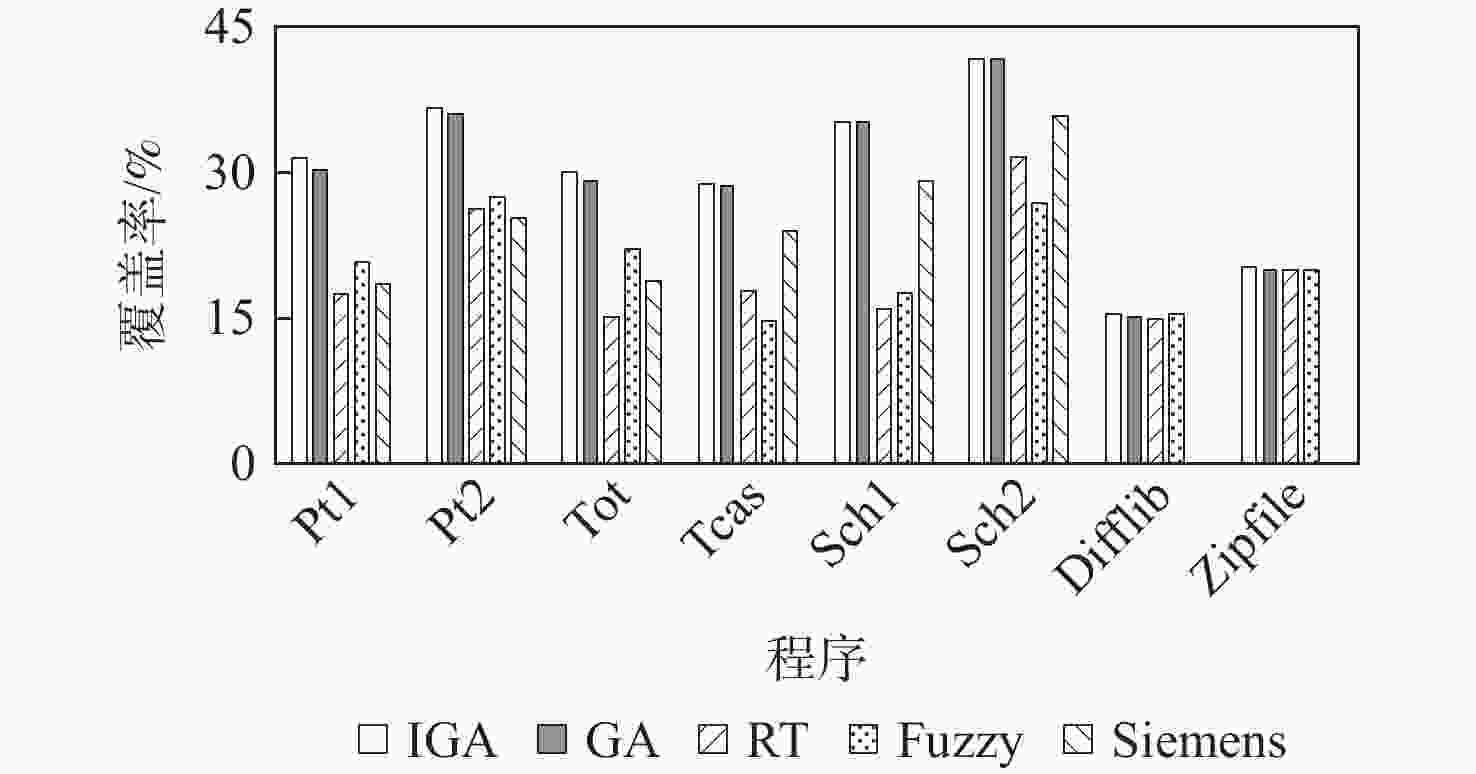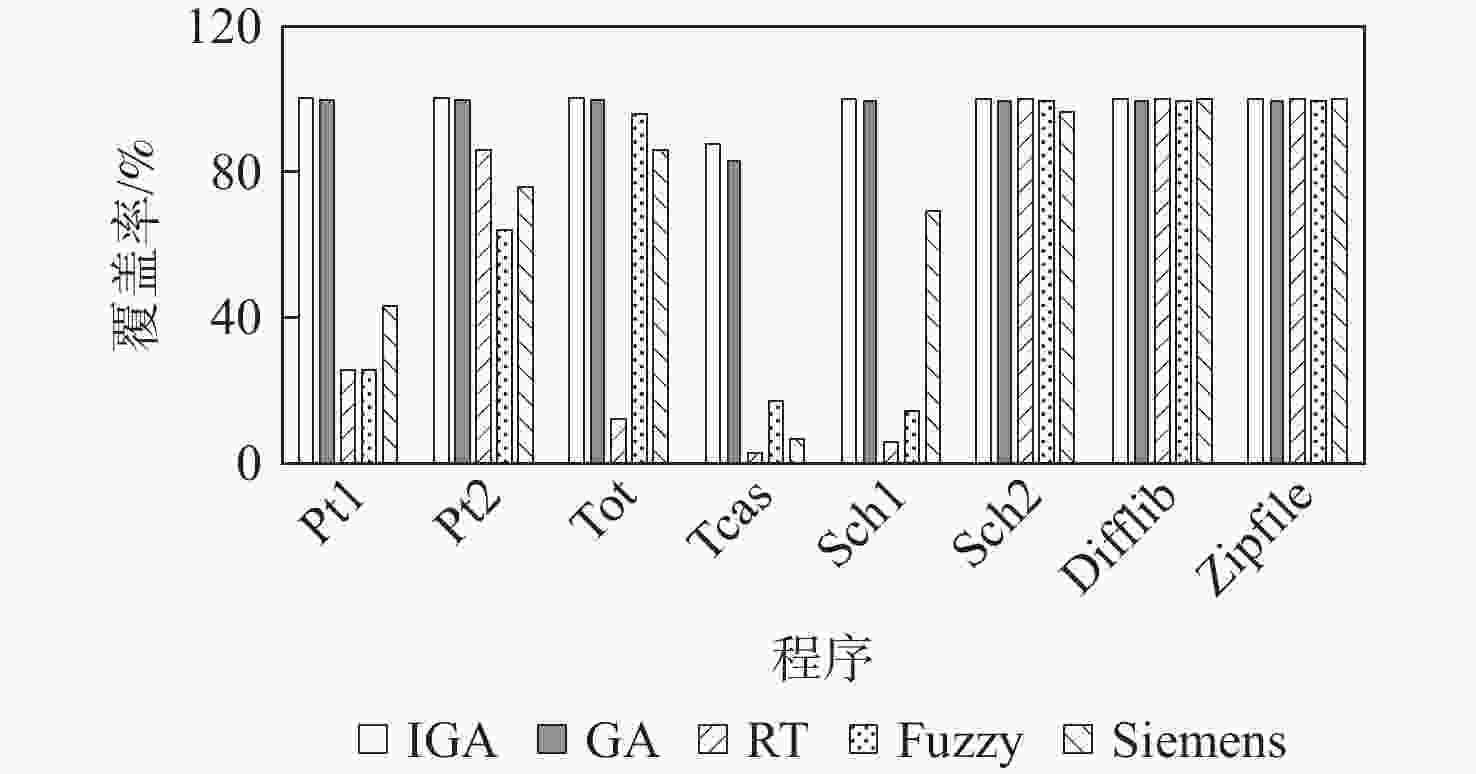Using improved genetic algorithm for software fault localization aided test case generation
-
摘要:
在软件故障自动化定位过程中,如果在给定的测试用例集合情况下故障在故障疑似度列表种排名不高,比较有效的方法为补充新的测试用例。如何在较小的代价下提升故障的可疑度排名是一项具有挑战的工作。提出一种基于改进遗传算法(IGA)的测试用例生成方法,利用软件故障定位的疑似故障排名,来辅助生成软件故障定位过程中的测试用例。依次对所提方法进行阐述和分析,在6个C程序和2个Python程序上开展实验,实验结果表明:所提方法自动生成的测试用例能够有效地帮助提高故障定位的效率。
Abstract:The ranking of suspected faults in the process of automatic software fault localization will be continuously created and is determined after the execution of existing test cases. Sometimes the program units corresponding to the fault are ranked lower in the ranking of suspected failures based on the existing test cases. If it is necessary to improve the suspected fault ranking of the program unit corresponding to the fault, supplementary test cases are a feasible method. This article suggests a technique for creating test cases based on a genetic algorithm that can make use of knowledge about the location of software faults. The paper analyzes and analyzes the methods used. Based on the joint experiment of the paper on 6 C programs and 2 Python programs, experimental results show that the test cases automatically generated by this method can effectively help improve the efficiency of fault location.
-
Key words:
- fault localization /
- test case generation /
- genetic algorithm /
- fitness function /
- random test
-
表 1 实验程序信息
Table 1. Experimental objects informations
程序 语句数 测试用例数目 Print_token1(Pt1) 563 4130 Print_token2(Pt2) 508 4115 Tcas 173 1607 Schedule1(Sch1) 410 2650 Schedule2(Sch2) 307 2710 Tot_info(Tot) 406 1052 Difflib 1937 100 Zipfile 2440 100 表 2 测试用例应用到故障定位的效率比较(Print_token1程序)
Table 2. Comparison of the efficiency of test case applied to fault location(Print_token1)
故障定位方法 原始检查
语句数目前检查
语句数检查语句
的减少率 /%XGBoost 62 6 90.32 D3Star 360 97 73.05 GP19 297 173 41.75 Ochiai1 297 97 67.34 表 3 测试用例应用到故障定位的效率比较(Print_token2程序)
Table 3. Comparison of the efficiency of test case applied to fault location(Print_token2)
故障定位方法 原始检查
语句数目前检查
语句数检查语句
的减少率/%XGBoost 160 16 90.00 D3Star 61 52 14.80 GP19 182 52 71.43 Ochiai1 64 61 4.69 表 4 测试用例应用到故障定位的效率比较(Tot_info程序)
Table 4. Comparison of the efficiency of test case applied to fault location(Tot_info)
故障定位方法 原始检查
语句数目前检查
语句数检查语句
的减少率/%XGBoost 49 24 51.02 D3Star 357 80 77.59 GP19 369 280 21.57 Ochiai1 357 80 77.59 表 5 测试用例应用到故障定位的效率比较(Schedule1程序)
Table 5. Comparison of the efficiency of test case applied to fault location(Schedule1)
故障定位方法 原始检查
语句数目前检查
语句数检查语句
的减少率/%XGBoost 8 6 50.00 D3Star 20 26 −30.00 GP19 128 139 −8.59 Ochiai1 20 26 −30.00 表 6 测试用例应用到故障定位的效率比较(Schedule2程序)
Table 6. Comparison of the efficiency of test case applied to fault location(Schedule2)
故障定位方法 原始检查
语句数目前检查
语句数检查语句
的减少率/%XGBoost 132 41 68.94 D3Star 92 16 82.61 GP19 92 16 82.61 Ochiai1 92 16 82.61 表 7 测试用例应用到故障定位的效率比较(Tcas程序)
Table 7. Comparison of the efficiency of test case applied to fault location(Tcas)
故障定位方法 原始检查
语句数目前检查
语句数检查语句
的减少率/%XGBoost 59 5 91.52 D3Star 72 32 55.00 GP19 84 60 28.57 Ochiai1 72 32 55.00 表 8 测试用例应用到故障定位的效率比较(Difflib程序)
Table 8. Comparison of the efficiency of test case applied to fault location(Difflib)
故障定位方法 原始检查
语句数目前检查
语句数检查语句
的减少率/%XGBoost 51 51 0 D3Star 136 47 65.44 GP19 136 47 65.44 Ochiai1 136 47 65.44 表 9 测试用例应用到故障定位的效率比较(Zipfile程序)
Table 9. Comparison of the efficiency of test case applied to fault location(Zipfile)
故障定位方法 原始检查
语句数目前检查
语句数检查语句
的减少率/%XGBoost 121 93 23.14 D3Star 336 146 56.55 GP19 336 146 56.55 Ochiai1 336 146 56.55 -
[1] TRACEY N J. A search-based automated test-data generation framework for safety-critical software[D]. York: The University of York, 2001. [2] HARMAN M, JONES B F. Search-based software engineering[J]. Information and Software Technology, 2001, 43(14): 833-839. doi: 10.1016/S0950-5849(01)00189-6 [3] RUAN H, ZHANG J, YAN J. Test data generation for C programs with string-handling functions[C]// 2008 2nd IFIP/IEEE International Symposium on Theoretical Aspects of Software Engineering. Piscataway: IEEE Press, 2008: 219-226. [4] DEMILLI R A, OFFUTT A J. Constraint-based automatic test data generation[J]. IEEE Transactions on Software Engineering, 1991, 17(9): 900-910. doi: 10.1109/32.92910 [5] PENG C, RAJAN A. Automated test generation for OpenCL kernels using fuzzing and constraint solving[C]//Proceedings of the 13th Annual Workshop on General Purpose Processing Using Graphics Processing Unit. New York: ACM, 2020. [6] YANG F, FAN Y, XIAO P, et al. Test data generation method based on multiple convergence direction adaptive PSO[J]. Software Quality Journal, 2022, 31: 279-303. [7] 杨波, 吴际, 徐珞, 等. 一种软件测试需求建模及测试用例生成方法[J]. 计算机学报, 2014, 37(3): 522-538.YANG B, WU J, XU L, et al. An approach of modeling software testing requirements and generating test case[J]. Chinese Journal of Computers, 2014, 37(3): 522-538(in Chinese). [8] BOYER R S, ELSPAS B, LEVITT K N. SELECT—a formal system for testing and debugging programs by symbolic execution[J]. ACM SIGPLAN Notices, 1975, 10(6): 234-245. doi: 10.1145/390016.808445 [9] MARCINIAK J J. Encyclopedia of software engineering[M]. Hoboken: JohnWiley & Sons, Inc., 2002. [10] HARMAN M, MCMINN P. A theoretical & empirical analysis of evolutionary testing and hill climbing for structural test data generation[C]//Proceedings of the 2007 International Symposium on Software Testing and Analysis. New York: ACM, 2007: 73-83. [11] METROPOLIS N, ROSENBLUTH A W, ROSENBLUTH M N, et al. Equation of state calculations by fast computing machines[J]. The Journal of Chemical Physics, 1953, 21(6): 1087-1092. doi: 10.1063/1.1699114 [12] PARGAS R P, HARROLD M J, PECK R R. Test-data generation using genetic algorithms[J]. Software Testing, Verification and Reliability, 1999, 9(4): 263-282. doi: 10.1002/(SICI)1099-1689(199912)9:4<263::AID-STVR190>3.0.CO;2-Y [13] LI X L, WONG W E, GAO R Z, et al. Genetic algorithm-based test generation for software product line with the integration of fault localization techniques[J]. Empirical Software Engineering, 2018, 23(1): 1-51. doi: 10.1007/s10664-016-9494-9 [14] SHEN X J, WANG Q, WANG P P, et al. Automatic generation of test case based on GATS algorithm[C]//2009 IEEE International Conference on Granular Computing. Piscataway: IEEE Press, 2009: 496-500. [15] NOSRATI M, HAGHIGHI H, VAHIDI ASL M. Test data generation using genetic programming[J]. Information and Software Technology, 2021, 130: 106446. doi: 10.1016/j.infsof.2020.106446 [16] SAHOO R R, RAY M. PSO based test case generation for critical path using improved combined fitness function[J]. Journal of King Saud University - Computer and Information Sciences, 2020, 32(4): 479-490. doi: 10.1016/j.jksuci.2019.09.010 [17] DI NUCCI D, PANICHELLA A, ZAIDMAN A, et al. A test case prioritization genetic algorithm guided by the hypervolume indicator[J]. IEEE Transactions on Software Engineering, 2020, 46(6): 674-696. doi: 10.1109/TSE.2018.2868082 [18] CAI G C, SU Q H, HU Z B. Automated test case generation for path coverage by using grey prediction evolution algorithm with improved scatter search strategy[J]. Engineering Applications of Artificial Intelligence, 2021, 106: 104454. doi: 10.1016/j.engappai.2021.104454 [19] GOTLIEB A, BOTELLA B, RUEHER M. Automatic test data generation using constraint solving techniques[J]. ACM SIGSOFT Software Engineering Notes, 1998, 23(2): 53-62. doi: 10.1145/271775.271790 [20] GUPTA N, MATHUR A P, SOFFA M L. Automated test data generation using an iterative relaxation method[J]. ACM SIGSOFT Software Engineering Notes, 1998, 23(6): 231-244. doi: 10.1145/291252.288321 [21] WANG C H, PASTORE F, GOKNIL A, et al. Automatic generation of acceptance test cases from use case specifications: An NLP-based approach[J]. IEEE Transactions on Software Engineering, 2022, 48(2): 585-616. doi: 10.1109/TSE.2020.2998503 [22] BERTOLINO A, MIRANDA B, PIETRANTUONO R, et al. Adaptive test case allocation, selection and generation using coverage spectrum and operational profile[J]. IEEE Transactions on Software Engineering, 2021, 47(5): 881-898. doi: 10.1109/TSE.2019.2906187 [23] CHEN T Y, LEUNG H, MAK I K. Adaptive random testing[C]//Annual Asian Computing Science Conference. Berlin: Springer, 2004: 320-329. [24] CAMPOS J, GE Y, ALBUNIAN N, et al. An empirical evaluation of evolutionary algorithms for unit test suite generation[J]. Information and Software Technology, 2018, 104: 207-235. doi: 10.1016/j.infsof.2018.08.010 [25] ZAMANI S, HEMMATI H. A cost-effective approach for hyper-parameter tuning in search-based test case generation[C]//2020 IEEE International Conference on Software Maintenance and Evolution. Piscataway: IEEE Press, 2020: 418-429. [26] ZAMANI S, HEMMATI H. A pragmatic approach for hyper-parameter tuning in search-based test case generation[J]. Empirical Software Engineering, 2021, 26(6): 1-35. [27] YANG B, HE Y Z, LIU H, et al. A lightweight fault localization approach based on XGBoost[C]//2020 IEEE 20th International Conference on Software Quality, Reliability and Security. Piscataway: IEEE Press, 2020: 168-179. [28] YANG B, HE Y Z, FENG L X. Automated test case generation for effective spectrum-based fault localization[J]. Journal of Physics: Conference Series, 2020, 1576(1): 012042. doi: 10.1088/1742-6596/1576/1/012042 -







 下载:
下载:







